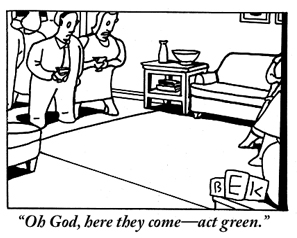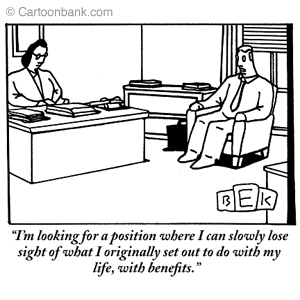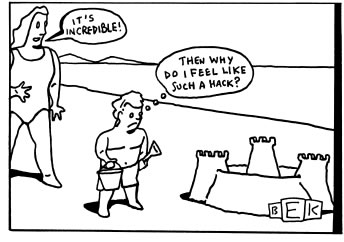Meg and I almost died laughing when we saw this one:

My buddy Tim just posted about the cartoon genius that is Bruce Eric Kaplan.
Meg and I almost died laughing when we saw this one:

My buddy Tim just posted about the cartoon genius that is Bruce Eric Kaplan.
I don’t know if I’ve made this clear in other posts, but Meg and I are absolutely, positively, without-a-doubt moving to Austin, Texas around the beginning of August. Meg will be attending the University of Texas to get her Master of Science in Sustainable Design, and I will be working full-time (yikes!) somewhere to support us.
What we are excited about:
What we are NOT excited about:
As our move approaches, I’ve been thinking more an more about quality of life — how easy we have it here in Cleveland, and how we might make it even better in Texas. For us, anxiety is usually only the product of Unknown Factors, and our Unknown Factors are big ones: Where To Live and Where to Work.
There was a New Yorker article on commuting a week or so ago (it coincidentally had a cool illustration of Glenn Ganges in traffic by Kevin Huizenga) that had a very practical way of looking at the Where To Live, Where To Work question:
Putnam likes to imagine that there is a triangle, its points comprising where you sleep, where you work, and where you shop. In a canonical English village, or in a university town, the sides of that triangle are very short: a five-minute walk from one point to the next. In many American cities, you can spend an hour or two travelling each side. “You live in Pasadena, work in North Hollywood, shop in the Valley,” Putnam said. “Where is your community?” The smaller the triangle, the happier the human, as long as there is social interaction to be had. In that kind of life, you have a small refrigerator, because you can get to the store quickly and often. By this logic, the bigger the refrigerator, the lonelier the soul.
Our triangle here in Cleveland is pretty small: we can’t walk to work, but we can and do walk to the grocery store, to the Chipotle, to the book store. I’m hoping we can find a similar situation in Austin.
As for the job search, I have this Bruce Eric Kaplan cartoon posted to the fridge:

If you are an employer — or if you know of an employer — in Austin who is looking for a writer/designer with plenty o’ computer, web design, and customer service experience…please contact me!

I have a confession to make. I haven’t been Working. I haven’t been Working, and I won’t be Working until sometime next year, when all this wedding craziness ends.
Does this bother me? Not as much as it should.
Actually, things have been quite pleasant. Minus the wedding anxiety dreams. Last night I had a dream that I overslept until five minutes before the ceremony, and my shirt wasn’t ironed, and I tripped over the power cord and severely burned my forearm, but instead of calling 9-11, I called my mom to make sure she stalled everybody until I could get there…
Now, I should be drawing this. I should be making cartoons of this.
But I don’t have a deadline to make. Thank you, baby Jesus.
There is an excellent Washington Post article today about the editorial process of selecting cartoons for the New Yorker and the new book, Rejection Collection: Cartoons You Never Saw and Will Never See In The New Yorker. In case you didn’t already now, even if you get a contract as a New Yorker cartoonist, your rejection rate on a good week is 80 or 90 percent — every week, New Yorker cartoonists send in 10 or more drawings, and at the very best, the editors pick one or two, at the very worst, they reject them all.
It’s tough being a cartoonist.
But there are a few perks. This is from the introduction to Bruce Eric Kaplan’s collection, This Is A Bad Time:
…these drawings are really my journals. I use them to explore whatever I find interesting, confusing, or upsetting on any given day. But here’s the beauty part—these private thoughts are filtered through the prism of moody children and blasé pets, disillusioned middle-aged men and weary matrons, among others. And so I get to work through whatever I am thinking about in a coded way. No one but me will ever know what the real seed of each image and caption was. So I can be as free as I want to say whatever I want, and no one can catch me. It’s great.
This site participates in the Amazon Affiliates program, the proceeds of which keep it free for anyone to read.